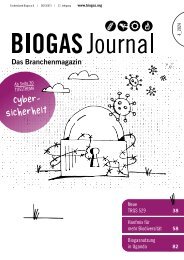Create successful ePaper yourself
Turn your PDF publications into a flip-book with our unique Google optimized e-Paper software.
Milk production in the<br />
south of Chile is based<br />
on grazing systems<br />
with an average of 5 to<br />
6 hours of confinement<br />
per day.<br />
English Issue<br />
Biogas Journal<br />
| <strong>Autumn</strong>_<strong>2017</strong><br />
Biogas as an energy source for<br />
the Chilean dairy sector<br />
Santiago de Chile<br />
Chile is probably the longest and narrowest country in the world. Its mainland<br />
is more than 4,000 km long with an average width of just 180 km. This provides<br />
the country with a great diversity of climates, soils and landscapes. Administratively,<br />
Chile is divided into 16 regions, but there are four large macro<br />
regions: Far North (Arica Parinacota to Atacama regions), predominantly a<br />
mining area in a country where this activity is the driving force of the economy;<br />
Near North and Central Chile (Coquimbo to El Maule regions), mainly agricultural<br />
areas with large production of wine, fruits and vegetables; the South<br />
(Biobio to Magallanes regions), largely dedicated to forestry with a significant<br />
presence of agriculture, livestock and fishing, which is also present in the rest<br />
of the country.<br />
By Marianela Rosas, Javier Obach and Christian Malebrán<br />
Given the aforementioned, it is apparent<br />
that Chile is a country where economic<br />
activity is strongly connected with the exploitation<br />
of natural resources, producing<br />
a significant amount of waste. This fact,<br />
along with the agreements signed for climate change<br />
mitigation, the existence of an energy policy with sustainability<br />
as one of its pillars, and increasingly strict<br />
environmental legislation, inspire efforts to explore biogas<br />
technology as an alternative for treating waste and a<br />
way of developing a local energy source.<br />
In this context, Chile’s dairy sector is attractive for the<br />
implementation of biogas, since it constitutes a significant<br />
activity for the local economy, where biogas generation<br />
is not new. The sector comprises approximately<br />
4,600 commercial producers with 10 to 5,000 cows<br />
each (information provided directly by Consorcio Lechero),<br />
with a large number of medium-sized producers<br />
(between 100 and 500 cows). Although the activity is<br />
carried out from the Valparaíso region (32º 02’ S) in<br />
the southern tip of the country, 84% of the cows are<br />
concentrated in the regions of Los Rios and Los Lagos<br />
(Consorcio Lechero, 2016). However, these regions<br />
have a mild, wet climate with rainfall of around 1,200<br />
mm/year and surface temperatures between 6 and 18°<br />
C. This means the cattle feed on grassland, which does<br />
not facilitate the collection of faeces and urine.<br />
The high rainfall in the area, along with the scarce adoption<br />
of measures to channel or collect rainwater and<br />
the excessive volumes of water used for washing yards<br />
42

















